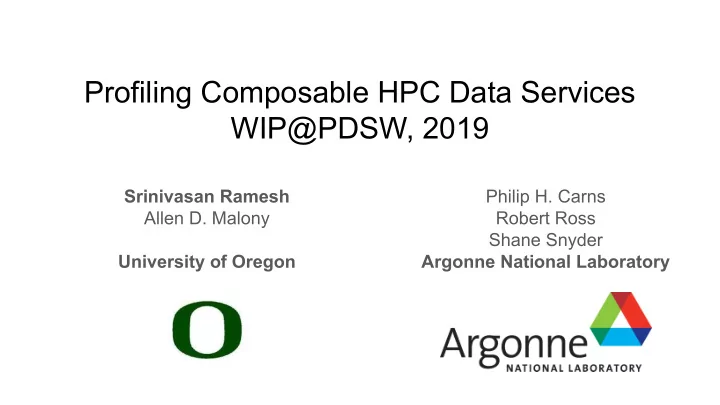

Profiling Composable HPC Data Services WIP@PDSW, 2019 Srinivasan Ramesh Philip H. Carns Allen D. Malony Robert Ross Shane Snyder University of Oregon Argonne National Laboratory
Data Services: Managing Heterogeneity and Change Storage: Applications: ● Difficult to build custom data services Heterogeneous, Diverse Workflows, Multi-layered Data-driven efficiently: ○ Lots of moving parts ○ Need to dynamically adapt to SSD Simulation NVM changing application patterns ● Debugging performance problems is hard: ARCHIVE ○ Numerous attempts at debugging DISKS Data microservices: Dapper@Google, Machine Analysis Learning Stardust, X-Trace, etc MEMORY ○ We take inspiration from these “KOVE” DEVICES
Mochi: Composable Data Services Mobject service: An object store ● Mochi data services are built by composing microservices: ○ RPC for control ○ RDMA for data movement ● Mochi’s building blocks: ○ Mercury , Argobots, Margo ● Performance Analysis in Mochi: ○ Build performance analysis capability directly into Mochi: ■ Available out-of-the-box! *Image credits: Matthieu Dorier, Argonne National Laboratory
Mochi: Performance Analysis Call path profiling: Mobject service: Call path profiling ● We track the time spent in various call paths within the service: ○ A->C->D is a different call path from B->C->D ● Key idea: Each microservice stores and forwards RPC call path ancestry ● Time, call count, resource-level usage statistics updated at four instrumentation points: Client send/receive, Server send/receive ● What performance questions do we hope to answer?
Call Path Profiling: Detecting Load Imbalance ● Performance question: For a given call path, what is the distribution of call path times and counts in origin/target entities? mobject_read_op: Raw distribution of call times across all origin (client) entities 15s 4.8s read bw: 5700 MiB/s read bw: 2155 MiB/s 3.4s 7s Overloaded server: Large variation in response time Multi-threaded server: Better read perf. and response time
Tracing: Detecting Resource-Level Inefficiencies ● Margo servers spawn a new Argobot User-Level-Task (ULT) for every incoming RPC request ○ Size of pool of tasks waiting to run is a measure of load and responsiveness of system ● We perform request tracing at the 4 instrumentation points previously described: ○ We collect Argobot pool size info, memory usage along request path ○ This enables correlation of call path behaviour with resource usage on node mobject_read_op: Max number of pending Argobot ULT’s along request path 20 pending tasks 7 pending tasks Overloaded server: Pending tasks are Multi-threaded server: Reduction in number stacking up of pending tasks
Recommend
More recommend